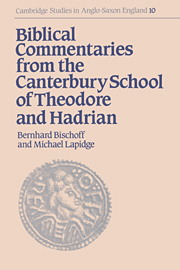Book contents
- Frontmatter
- Contents
- Preface
- List of abbreviations
- 1 Introduction
- 2 Archbishop Theodore
- 3 Abbot Hadrian
- 4 Theodore and Hadrian in England
- 5 The sources of the Canterbury biblical commentaries
- 6 The nature of the Canterbury biblical commentaries
- 7 The manuscripts
- Texts and translations
- Commentary to the texts
- Appendix I Additional manuscript witnesses to the Milan biblical commentaries
- Appendix II Two metrological treatises from the school of Canterbury
- Fig. 1 Cilicia and Syria
- Fig. 2 Constantinople in the seventh century
- Fig. 3 Churches and monasteries of seventh-century Rome
- Fig. 4 Cyrenaica and the Pentapolis
- Fig. 5 Campania and the Bay of Naples
- Fig. 6 Palestine
- Bibliography
- Index of Old English words quoted in the texts
- Index of Greek words quoted in the texts
- Index of names cited in the texts
- General index
7 - The manuscripts
Published online by Cambridge University Press: 08 January 2010
- Frontmatter
- Contents
- Preface
- List of abbreviations
- 1 Introduction
- 2 Archbishop Theodore
- 3 Abbot Hadrian
- 4 Theodore and Hadrian in England
- 5 The sources of the Canterbury biblical commentaries
- 6 The nature of the Canterbury biblical commentaries
- 7 The manuscripts
- Texts and translations
- Commentary to the texts
- Appendix I Additional manuscript witnesses to the Milan biblical commentaries
- Appendix II Two metrological treatises from the school of Canterbury
- Fig. 1 Cilicia and Syria
- Fig. 2 Constantinople in the seventh century
- Fig. 3 Churches and monasteries of seventh-century Rome
- Fig. 4 Cyrenaica and the Pentapolis
- Fig. 5 Campania and the Bay of Naples
- Fig. 6 Palestine
- Bibliography
- Index of Old English words quoted in the texts
- Index of Greek words quoted in the texts
- Index of names cited in the texts
- General index
Summary
The Canterbury biblical commentaries have been transmitted in various manuscripts, none of which preserves a complete text in its original form. The principal (and most complete) manuscript is that in Milan; but the other, often fragmentary, manuscripts throw important light on the original form of the commentaries; furthermore, they are in every case earlier by several centuries than the Milan manuscript. The earliest of these manuscripts, a fragment now in Berlin dating from the mid-eighth century, thus dates from roughly a half-century after the commentaries were first committed to writing. Before considering these earlier but fragmentary witnesses, however, it is necessary to treat the Milan manuscript in some detail.
MILAN, BIBLIOTECA AMBROSIANA, M. 79 SUP.
The Milan manuscript was designed by its two principal scribes as a massive theological compendium. On palaeographical grounds, it appears to have been written in northern Italy in the second half of the eleventh century. It consists of 254 folios in large quarto size (260 X 190 mm.), with a written space of 200 X 145 mm. Pricking was done with a slanted, slit-shaped instrument of the sort commonly found in Italian manuscripts of this date. The first quire was ruled for 41 long lines, but all the remaining quires have been ruled for two columns (65 + 15 + 6 5 mm.). The parchment is yellow in appearance and of poor quality; the ink is brown.
- Type
- Chapter
- Information
- Publisher: Cambridge University PressPrint publication year: 1995

